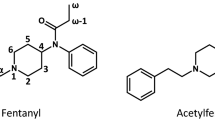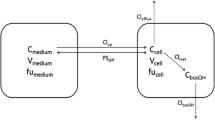Abstract
Conventional analysis of initial uptake and egress rates in isolated hepatocytes is limited in the ability to distinguish between rates of metabolite formation and egress, and to separate basolateral and canalicular transport processes. The present study examined the applicability of kinetic modeling in describing acetaminophen glucuronide (AG) and acetaminophen sulfate (AS) formation and egress in hepatocytes after acute exposure to phenobarbital or p-hydroxyphenobarbital glucuronide p-OHPBG) in vitro,or in vivophenobarbital pretreatment. A significant pretreatment effect on AG and AS disposition was seen based on initial rates of egress. In vivophenobarbital pretreatment decreased the initial egress rate of AG compared to vehicle pretreatment, and the initial egress rate of AS compared to all other treatments. A pharmacokinetic model incorporating AG and AS formation in hepatocytes as well as egress processes (including diffusional and active transport components) was fit to the data. Parameter estimates derived from model fits to the data showed the expected increase in acetaminophen glucuronidation and decrease in sulfation after phenobarbital pretreatment;in addition, an increase in the AG diffusional rate constant and a decrease in the AS diffusional rate constant was apparent. The excretion Vmax for AG was decreased statistically after acute phenobarbital exposure in vitro,and in vivophenobarbital pretreatment, with a concomitant statistical increase in the KmforAG excretion. In vitroacute p-OHPBG exposure also decreased significantly the excretion Vmax for AG. These data are consistent with the hypothesis that phenobarbitalimpaired biliary excretion of AG is a function of impaired canalicular transport due to the presence of p-OHPBG. They further suggest that the mechanism may not be simple competitive inhibition. This work demonstrates the utility of a kinetic modeling approach to differentiate metabolic and transport processes when analyzing data from isolated hepatocyte studies. Additional information may be gained that would not be apparent by conventional methods of analysis.
Similar content being viewed by others
References
P. O. Seglen. Preparation of isolated rat liver cells.Meth. Cell. Biol. 13:29–83 (1976).
M. H. Wisher and W. H. Evans. Enzymes of the hepatocyte plasma membrane. In H. Popper (ed.),Membrane Alterations as Basis of Liver Injury, MTP Press, Lancaster, 1977, pp. 127–141.
G. M. M. Groothuis, C. E. Hulstaert, D. Kalicharan, and M. Hardonk. Plasma membrane specialization and intracellular polarity of freshly isolated rat hepatocytes.Eur. J. Cell. Biol. 26:43–51 (1981).
S. Kato, K. Aoyama, T. Nakamura, and A. Ichihara. Biochemical studies on liver func-tions in primary cultured hepatocytes of adult rats. III. Changes of enzyme activities on cell membranes during culture.J. Biochem. 86:1419–1425 (1979).
A. Blom, A. H. Scaf, and D. K. F. Meijer. Hepatic drug transport in the rat. A comparison between isolated hepatocytes, the isolated perfused liver and the liverin vivo.Biochem. Pharmacol. 31:1553–1565 (1982).
A. L. Hubbard, D. A. Wall, and A. Ma. Isolation of rat hepatocyte plasma membranes. I. Presence of the three major domains.J. Cell Biol. 96:217–229 (1983).
T. Coche, X. Deroubarx, E. Depiereux, and E. Feytmans. Compartmental analysis of steady-state taurocholate transport kinetics by isolated rat hepatocytes.Hepatology 13:1203–1214 (1991).
S. Iida, T. Mizuma, N. Sakuma, M. Hayashi, and S. Awazu. Transport of acetaminophen conjugates in isolated rat hepatocytes.Drug Metab. Dispos. 17:341–344 (1989).
M. H. DeVries, G. M. M. Groothuis, G. J. Mulder, H. Nguyen, and D. K. F. Meijer. Secretion of the organic anion harmol sulfate from liver into blood. Evidence for a carriermediated mechanism.Biochem. Pharmacol. 34:2129–2135 (1985).
R. Grafstrom, K. Ormstad, P. Moldeus, and S. Orrenius. Paracetamol metabolism in the isolated perfused rat liver with further metabolism of a biliary paracetamol conjugate by the small intestine.Biochem. Pharmacol. 28:3573–3579 (1979).
K. L. R. Brouwer and J. A. Jones. Altered hepatobiliary disposition of acetaminophen metabolites after phenobarbital pretreatment and renal ligation: Evidence for impaired biliary excretion and a diffusional barrier.J. Pharmacol. Exp. Ther. 252:657–664 (1990).
S. D. Studenberg and K. L. R. Brouwer. Phenacetin and acetaminophen metabolism in the isolated perfused rat liver. Precursor concentration influences the selection of kinetic parameters to assess hypoxic impairment.Drug Metab. Dispos. 19:423–429 (1991).
C. D. Klaassen and J. B. Watkins. Mechanisms of bile formation, hepatic uptake and biliary excretion.Pharmacol. Rev. 36:1–67 (1984).
M. H. Nathanson and J. L. Boyer. Mechanisms and regulation of bile secretion.Hepatology 14:551–566 (1991).
W. Loeser and C.-P. Siegers. Effects of phenobarbital, phorone and carbon tetrachloride pretreatment on the biliary excretion of acetaminophen in rats.Arch. Int. Pharmacodyn. Ther. 275:180–188 (1985).
Z. Gregus, C. Madhu, and C. D. Klaassen. Effect of microsomal enzyme inducers on biliary and urinary excretion of acetaminophen metabolites in rats. Decreased hepatobiliary and increased hepatovascular transport of acetaminophen-glucuronide after microsomal enzyme induction.Drug Metab. Dispos. 18:10–19 (1990).
S. D. Studenberg and K. L. R. Brouwer. Impaired biliary excretion of acetaminophen glucuronide in the isolated perfused rat liver after acute phenobarbital treatment andin vivo phenobarbital pretreatment.J. Pharmacol. Exp. Ther. 261:1022–1027 (1992).
G. J. Mulder. The rate-limiting step in the biliary elimination of some substrates of uridine diphosphate glucuronyltransferase in the rat.Biochem. Pharmacol. 22:1751–1763 (1973).
S. D. Studenberg, K. L. R. Brouwer, D. L. Price-Raybuck, and R. Spreen. Characterization of p-hydroxyphenobarbital glucuronide from immobilized rat hepatic UDP-glucuronyltransferase.Toxicologist 12:386 (1512) (1992).
W. J. Brock and M. Vore. Characterization of uptake of steroid glucuronides into isolated male and female rat hepatocytes.J. Pharmacol. Exp. Ther. 229:175–181 (1984).
O. H. Lowry, N. J. Rosebrough, A. L. Farr, and R. J. Randall. Protein measurement with the Folin phenol reagent.J. Biol. Chem. 193:265–275 (1951).
H. Baur, S. Kasperek, and E. Pfaff. Criteria of viability of isolated liver cells.Hoppe-Seylers Z. Physiol. Chem. 356:827–838 (1975).
W. Bolanowska and T. Gessner. Drug interactions with acetaminophen: Effects of phenobarbital, prednisone, and 5-fluorouracil in normal and tumor-bearing rats.Biochem. Pharmacol. 29:1167–1175 (1980).
M. Davies and I. J. Whitting. A modified form of Levenberg's correction. InNumerical Methods for Non-Linear Optimization, Academic Press, New York, 1972.
H. O. Hartley. The modified Gauss-Newton method for the fitting of nonlinear regression functions by least squares.Technometrics 3:269–280 (1961).
P. Moldeus, B. Andersson, A. Norling, and K. Ormstad. Effect of chronic ethanol administration on drug metabolism in isolated hepatocytes with emphasis on paracetamol activation.Biochem. Pharmacol. 29:1741–1745 (1980).
D. J. Sweeney and L. A. Reinke. Effect of ethanol feeding on hepatic microsomal UDP-glucuronyltransferase activity.Biochem. Pharmacol. 36:1381–1383 (1987).
G. S. Yost and B. L. Finley. Ethanol as an inducer of UDP-glucuronyltransferase: A comparison with phenobarbital and 3-methylcholanthrene induction in rabbit hepatic microsomes.Biochem. Biophys. Res. Comm. 111:219–223 (1983).
N. Watari, M. Iwai, and N. Kaneniwa. Pharmacokinetic study of the fate of acetaminophen and its conjugates in rats.J. Pharmacokin. Biopharm. 11:245–272 (1983).
T. Mizuma, M. Hayashi, and S. Awazu. Factors influencing drug sulfate and glucuronic acid conjugation rates in isolated rat hepatocytes.Biochem. Pharmacol. 34:2573–2575 (1985).
Author information
Authors and Affiliations
Rights and permissions
About this article
Cite this article
Studenberg, S.D., Brouwer, K.L.R. Effect of phenobarbital andp-hydroxyphenobarbital glucuronide on acetaminophen metabolites in isolated rat hepatocytes: Use of a kinetic model to examine the rates of formation and egress. Journal of Pharmacokinetics and Biopharmaceutics 21, 175–194 (1993). https://doi.org/10.1007/BF01059769
Received:
Revised:
Published:
Issue Date:
DOI: https://doi.org/10.1007/BF01059769




